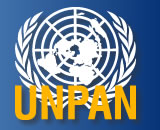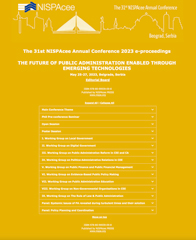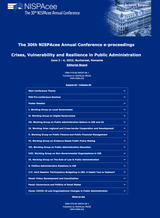WG Programme Coordinators:
Patrycja Suwaj, Polish Association for PA Education; Bialystok University, Poland
E-mail: psuwaj@wsap.edu.pl
Hans Joachim Rieger, Head of department in dbb academy, Bonn, Germany
E-mail: h.rieger@dbbakademie.de
NISPAcee Project Manager:
Viera Wallnerova, Email: wallnerova@nispa.org
Theme 2011:
General: Civil Service models in the EU and CEE countries
Specific: HR policy and instruments
About working group
The announced 2009 Working Group on Civil Service was the new WG within the NISPAcee. We would follow to start cross-countries discussion and encourage people from different countries holding different backgrounds to present and discuss various models Human Resources (HR), commonalities and differences among CEE states comparing to the EU countries and USA.
In addition to that scientific approach we would like to start practical input and experience exchange for the implementation of a selected precise HR Instruments in different countries.
Background and justification
In the 21st century, demographic developments, growing expectations from citizens, the introduction of new technologies, individualization, delegation and decentralization, financial pressures and internationalization trends have become the determining factors of change in the public service. Today, reform measures promote the deconstruction and the decentralization of the civil service at all fronts. In addition, public policies are administered through increasingly complex networks, decentralized governance structures, public-private partnerships and cooperative ventures between NGO’s, consultants and Government (Ch. Demmke). The traditional concept of the public service as a single, unified employer is also disappearing. Instead, the introduction of individual performance schemes and the decentralization of responsibilities in Human Resources Management (HRM) make the public service a rather heterogeneous and fragmented body. Contrary to this, for a long time the single employer concept was vital to the development of centralized public personnel systems. A government rather than its individual agencies, was the employer. Accordingly, the employee was a career civil servant rather than a worker (D. H. Rosenbloom/R. S. Kravchuk).
In the past years, many areas of the public sector have lost this uniqueness and have become quite similar to the general employment system. What is interesting us from the CEE point of view: does it mean that the idea of a civil service as a specific structure is outdated all over the Europe, at least in some countries, does it also happen to the New Member States. How the situation looks like in candidate countries?
There are now as many different categories of public employees as there are different public functions and organizations, and the term “civil servant” now is more difficult to define than ever. Modern civil servants have very different tasks, positions, legal relationships and working conditions in various European countries.
A civil servant or public servant is a civilian career public sector employee working for a government department or agency. The term always includes the (sovereign) state's employees; whether regional, or sub-state, or even municipal employees are called "civil servants" varies from country to country.
Many consider the study of civil service to be a part of the field of public administration. Workers in "non-departmental public bodies" (sometimes called ”quangos") may also be classed as civil servants for the purpose of statistics and possibly for their terms and conditions. Collectively a state's civil servants form its Civil Service or Public Service.
After the 2009 and 2010 conferences when we started with the disscussion and make general overwiev of civil services in CEE countries, we decided to focus in 2011 on the topic of human ressources management in civil service.
Our intention is not only to bring together general concepts. We would like to sum up the series of conferences with a handbook concerning civil service systems in CEE countries.
The handbook will serve the interests of practitioners and of applied scientists.
Call for papers
The membership of the Working Group on Civil Service seeks to build connections between reflective practitioners and engaged scholars in the Civil Service in CEE field, as a matter of priority. The primary objective of the Group is to enrich the 2011 NISPAcee Conference program with concept and models, structures, tasks of HR in Civil Services in CEE including academic and practice papers both.
.
We are inviting all member institutions, associate and individual members, as well as others interested in the topics of Civil Service in Central and Eastern Europe for participation and discussion about:
Specific topics we would like to discuss are (results of the needs assessment 2009 and 2010): The term civil service has usually three ways of subdividing:
1. HR Policy and Strategy
- Concepts of HR in different countries
- best practise in HRM/CS Reform,
- Conditions of service in various European countries,
- Comparison of civil servants of various sectors (government, an Agency, local government),
- Career systems and position systems.
2. Tools and instruments
To improve the service and the work performance a lot of instruments are in place. How are the instruments working? Which solutions are in practise? What are the results for public service servants?
- recruitment,
- staff selection,
- selection and recruitment of top managers,
- performance management,
- Regulations on performance appraisals,
- promotion,
- promotion system,
- salary system,
- classification / compensation system reform,
- modernisation of HR management and information system for HR,
For the two topics in bold letters please bring impleented systems of your country with you to the conference.
3. Qualification, Training and education
The qualification and needs for the public service differ in the way which concept the particular civil service follows. Therefore the approaches for education and training differ as well. Nevertheless there are some common roots for the education and training system in the different states.
Very important is the influence between science and research on the one hand and the practical approaches for training on the other hand. The institutional solutions and organisation forms, differ a lot between the east and the west countries between the EU and non EU countries.
The requirements for life long learning and continuous learning are visible in all civil service. How do the solutions in CEE countries look like and what are the benefits and deficits in these approaches? Which results could be achieved?
- management training using competency profiles for modern training programs for civil servants,
- what educational requirements should be for entering the civil service system,
- public administration education and training need quality control,
- are there specific needs of CEE countries?
- Regulations on training
- Personal development




 Price:
Price: 








